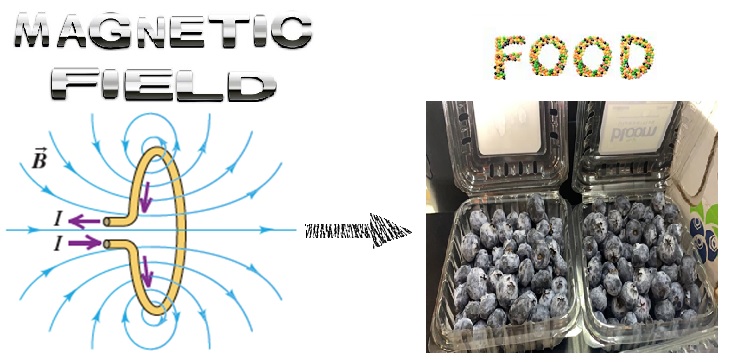Magnetic fields (MF) are increasingly being applied in food processing to preserve food quality. They can be static (SMF), oscillating (OMF) or pulsed (PMF) depending on the type of equipment. The food characteristics can be influenced by several configurations of the applied magnetic field as its flux density, frequency, polarity, and exposure time. Several mechanisms have been proposed to explain the effects of magnetic fields on foods. Some of them propose interactions at the subatomic particle level that show quantum behavior, such as the radical pair and cyclotron resonance mechanisms. Other proposals are at the level of DNA, compounds, subcellular organelles, and cells. The interactions between food and magnetic fields are addressed in a general way in this work, highlighting the applications and action model
- electromagnetic fields
- physicochemical characteristic
- enzyme activity
- microorganism inactivation
- magnetic fields mechanisms
1. Definition
Detailed revision emphasizing the magnetic variables involved in food processing.
This paper shows evidence of magnetic action in food properties.
The model of Magnetic field interaction with food is discussed.
2. Introduction
The use of emerging technologies for food preservation is increasing, among them, the magnetic fields have the potential to be applied in the different processing steps. In this context, the objective of this research was to develop a pulsed magnetic field generator equipment to test its application in food freezing, specifically in the physical and chemical characteristics of blueberries. Blueberry is a perishable fruit with a high concentration of bioactive compounds such as anthocyanins and polyphenols that need to be preserved. The equipment developed was a portable electromagnet whose field density can be adjusted according to voltage input up to 220 V and at frequencies from 0.5 Hz to 200 Hz. Also, an electronic system (Data Logger) was developed to collect real-time data from both magnetic fields and temperatures.
3. Applications and Influences
With the help of this system, it was possible to deter
mine the non-uniform or homogeneous distribution of magnetic fields in the test space by setting the RMS values at 36.8 mT and 44.7 mT at magnetic flux density and frequencies 30, 60, 90, and 120 Hz during the experiment. In the characterization of the magnetic fields in the test space, it was evident that at frequencies above 10 Hz there is the magnetization phenomenon of the electromagnet core, which allows the static (≥ 30 mT) and pulsed (above the static) magnetic fields to coexist simultaneously. This dual behavior was responsible for changes in the characteristics of blueberry freezing (time and temperature of nucleation, degree of supercooling, phase change time, and final freezing temperature) when compared to conventional freezing. The magnetic flux density of 44.7 mT and 90 Hz frequency allowed to improve the blueberry freezing process. At this condition the highest degree of supercooling and shorter phase change time was obtained, characteristics that cause greater nucleation in the water phase change, forming smaller and more uniform ice crystals. These facts were evidenced in the better preservation of the cell membranes, which was confirmed by the bioelectrical impedance technique. This condition also showed better preservation of anthocyanins and phenolic compounds with a consequent improvement in antioxidant activity. This did not occur for sugars (° Brix) and acids (titratable acidity) which remained constant in all treatments. The polyphenol oxidase and peroxidase enzymes had reduced activity in the applied treatments. From the results, it can be concluded that assisted freezing with pulsed magnetic fields alters the physical and chemical characteristics of blueberries. With a flow density of 44.7 mT and 90 Hz, better preservation of the blueberry structure is achieved and consequently the preservation of anthocyanins and polyphenols. This fact reinforces the possibility of using this technology for the preservation of bioactive compounds in fruits during freezing.
MFs applied in different frameworks lead to promising results in the transformation and preservation of some foods with respect to their physicochemical, enzymatic, and microbiological characteristics. As the food industry includes various food types, further studies are required to elucidate the levels and factors to be tuned to obtain specific results and also to understand the underlying action models. Until now, the action models that have been related to the biological systems like foods are the radical pair mechanism, ion cyclotron resonance, the formation of free radicals, and structural changes of proteins and DNA.
To understand the effects of MFs on foods it is necessary to determine the magnetic and electric properties of food components and to conduct research both at the quantum level and at compound and system level, which today can be supported by various instrumental techniques and assisted by disciplines such as spintronics, bioinformatics, and proteomics, among others. All these techniques will be useful to test different hypotheses and models regarding the action of the magnetic field in food.
This entry is adapted from the peer-reviewed paper 10.3390/pr8070814

